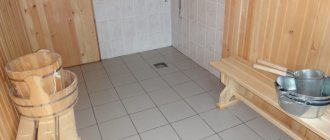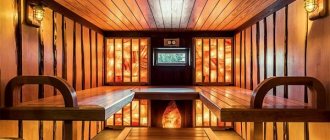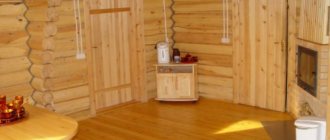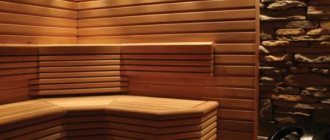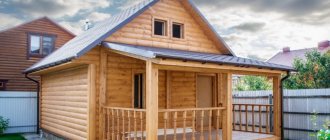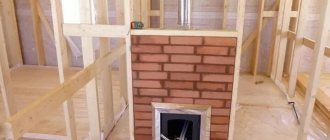Finishing a bath or sauna involves choosing high-quality materials that are resistant to high humidity and a wide range of high temperatures.
The correct choice of finishing material is dictated, first of all, by standard sizes, variety of shapes, textures and colors, as well as basic performance characteristics.
For this reason, the best option for baths and saunas is porcelain stoneware.
It is resistant to steam and strong mechanical loads, easy to process, safe and durable in use.
Installation of beacons
To create a flat concrete surface, a prerequisite is the installation of guides along which the liquid concrete will be leveled on a plane using a rule.
As a rule, they use metal beacons, which can be purchased at any hardware store. The correct implementation of this stage of work directly affects the quality of the surface arranged in this way. During the installation process you will need the following tools and materials:
1) lighthouses;
2) roulette;
3) metal scissors;
4) a dry mixture that has the property of rapid hardening (it can be used as a starting putty mixed with the same amount of alabaster);
5) a narrow spatula or trowel;
6) a container for mixing the mixture (you need to add a little water to the two components and mix them well);
7) construction level.
In order for them to be firmly fixed, they should be installed on a pre-prepared mixture. The required amount of it (in the form of lumps the size of a palm) must be placed on a layer of waterproofing in the future location of the guide so that along its length there are gaps of approximately 25–30 centimeters between the “piles” of solution. Both ends of the beacon must be installed on the prepared mixture (they should not “hang” in the air). All this must be done quickly enough, otherwise the solution will dry out ahead of time and it will no longer be possible to use it. The thickness of the future screed must be at least 5 centimeters, otherwise it may crack over time. It is best when the value of this parameter is 7 cm.
When installing beacons, be sure to use a level so that each guide is not only perfectly horizontal, but also in the same plane with other beacons.
After the mixture under the beacons has hardened, you can begin pouring the concrete screed.
Applying adhesive to the surface
Considering that I made the screed perfectly, the layer of glue turned out to be minimal. There is nothing complicated about applying the composition. First, using a regular spatula, it is laid out on the floor in a layer slightly higher than the height of the comb tooth. I used a 4mm tool. After the glue is spread over the surface, the excess is removed with a comb. The resulting “channels” act like a suction cup, helping to fix the tile even more tightly and firmly. The air that gets inside easily escapes through them.
The size of the comb should be selected based on how smoothly the screed is made. The fact is that if there are holes or potholes in it, a small tooth will not work - air bubbles will remain in the places of defects. My personal experience confirms that it is precisely such places that become the weak link. A glass jar falling on a point under which there is air can easily break porcelain tiles. But the complete absence of air between the floor surface and the coating eliminates damage. I personally dismantled high-quality laid tiles. Believe me, it is not easy to break even with a hammer.
Proper application of the adhesive ensures maximum durability of the coating.
Choosing tiles for the floor in the bathhouse
The tile must have a corrugated rough surface
In order for the ceramic tiles on the bathhouse floor to serve you faithfully for many years, and at the same time not cause injury to vacationers, you need to choose the right facing material. Since there are special requirements for tiles for finishing a bath:
- The tile must have a corrugated rough surface. Laying such cladding will provide an anti-slip effect and prevent possible falls. Therefore, it is best to choose this kind of material for laying the floor in the washroom and other rooms of the bathhouse.
- Bath tiles should have low porosity on the back side. As a result, the cladding will not absorb moisture, which contributes to the long service life of the material.
- Tiles for lining the floor in the washroom and other rooms of the bathhouse must be strong and durable. The ideal option is glazed tiles that are double fired. As a result, the strength of such tiles increases significantly.
- The dimensions of the tiles for a bathhouse should be smaller, the more complex the configuration of the slope of the floor to the drain. Thus, the process of laying tiles in the washing room will be simplified. The ideal option that you can choose is ceramic mosaic. But here the cost of the material often does not play into the hands of the bathhouse owners. So the choice is yours.
What to put it on
Since porcelain stoneware has very low hygroscopicity, laying it on a regular cement-sand mortar is a waste of time and money.
Water is not absorbed into the surface of this material, and the tile practically does not stick. It is with this adhesive composition that the finish “bounces off”. There is almost no adhesion with the solution. It is better to lay porcelain tiles using special glue
For heavy facing materials, special glue is made with a large number of polymer additives. This composition has many times greater adhesive ability, so that even with very low hygroscopicity, porcelain stoneware holds well. You should not use cement-sand mortar for installation. In this case, there is a high probability that the tiles will separate from the floor or walls during operation. You will have to take it out, hollow out the mortar, prime it and set the porcelain tiles on a special glue.
Types of tiles
There are many types of finishing tiles, and each of them has its own advantages.
Clinker tiles
It is made from a mixture of several types of clay, fired at a very high temperature, due to which it has the highest heat resistance, strength, resistance to mechanical and chemical influences. The thickness is from 9 to 12 mm, so such tiles are often used for lining the stove and adjacent walls.
Clinker floor tiles
In terms of water resistance, clinker tiles are equal to porcelain stoneware, and therefore are ideal for washroom floors.
Terracotta tiles
This species is distinguished by its porosity and rich brown color. These tiles are not glazed and look as natural as possible. Thanks to its porous structure, the material perfectly withstands sudden temperature changes, does not deform or crack, therefore it is considered the best option for lining heated surfaces. To finish the sauna stove, tiles with a thickness of 8 mm or more are used, with the addition of fireclay and quartz sand, as well as refractory clay.
| Appearance | Name of invoice | Standard | Size(mm) |
| "CHAMOT" | Straight ST1 Straight ST6 Straight ST4 | 70×240 123×263 150×310 | |
| "OLD LOCK" | Straight ST1 Straight ST6 Straight ST4 | 70×240 123×263 150×310 | |
| "TORGEN STONE" | Straight ST1 Straight ST6 Straight ST8 | 70×240 123×263 270×405 | |
| "OLD BRICK" | straight CT1 | 70×240 |
Coil tiles
Serpentine is a semi-precious green mineral. Each tile made from this stone has its own unique pattern, which is why it is so highly valued. In addition, the coil has certain healing properties that are revealed when heated. That is why coil tiles are used mainly for lining sauna stoves. The disadvantages of this material include its high cost and sensitivity to sudden temperature changes. Direct exposure to water is also undesirable, since it leaches calcium and contributes to the destruction of the stone.
Coil tiles
Soapstone tiles
A rock called soapstone has the ability to heat up very quickly and retain heat. Tiles made from this stone can withstand sudden temperature changes without any consequences, and for a very long time. Despite its strength, the material is easy to process, giving the product the desired shape. The cost of soapstone tiles is very high, so in most cases they are used for lining the stove and adjacent walls, but they are rarely found as flooring.
| Name | Qty | Price |
| Tile 90x90x10 (textured) | 90 pcs. | 3600.00 rub. |
| Tile 90x90x10 (regular) | 90 pcs. | 3330.00 rub. |
| Tile 300x300x10 (textured) | 10 pieces. | 5900.00 rub. |
| Tile 300x300x10 (regular) | 10 pieces. | 5300.00 rub. |
| Tile 57x220x10 (regular) | 10 pieces. | 900.00 rub. |
| Tile 50x200x20 (torn stone) | The price is per package (0.5 sq.m.) | 3300.00 rub. |
| Corner 300x40x40 | 1 PC. | 700.00 rub. |
Tile
Tile for finishing a sink or shower is considered the most popular material. It is easy to clean, does not emit harmful substances, has the necessary strength and durability - these are the main advantages of quite ordinary tiles.
Modern digital printing on ceramic tiles
Tiles with photo printing are suitable for finishing the washing compartment of a bathhouse
Ceramic mosaic
Ceramic mosaics are used very often in saunas and baths. The most popular use of mosaics is finishing the sink and the sides of the font, as well as decorating interiors with a variety of panels. Like tiles, mosaics are highly water resistant, withstand temperature changes well, and last a long time. Laying this material requires patience and accuracy, although the process itself is not too complicated.
Porcelain tiles
| Appearance | Area per package, m2 | Tile size | Price per 1 m2 | Price for 1 package |
| Caesar | 1,307 | 33x33 cm | 615,00 | 803,81 |
| Santorini | 1,42 | 45x45 cm | 415,80 | 590,43 |
| Calsta | 1,41 | 42×42 | 495,04 | 698,00 |
| Calsta Pattern | 1,41 | 42×42 | 495,04 | 698,00 |
| Trentino | 1,215 | 45x45 | 626,00 | 760,59 |
| Mezzanine | 1,41 | 42×42 | 784,30 | 1 105,86 |
Having studied and compared the characteristics of the described types of tiles, you can easily choose a finishing material for your bath. Do not forget that tile adhesive and grout must also be heat- and water-resistant, because the quality of the coating largely depends on these components. And one more thing - the smaller the tile and the more complex its shape, the longer the installation will take. If you are going to do the tiling yourself, but do not yet have the relevant experience, it is better not to buy small figured tiles. Adjusting the edges and aligning the seams requires patience and great care, because any discrepancies are immediately noticeable.
Porcelain tiles
In the manufacture of porcelain tiles, the same components are used as in the manufacture of ceramic tiles, but the method of its production is different. When creating porcelain tiles, the entire mixture is painted with pigment, which allows for a structure that is uniform in thickness, whereas in ceramic tiles only the top enamel layer is painted. Thanks to this technology, porcelain tiles do not need to be additionally coated with enamel.
First, tiles are formed from the prepared mixture, then they are pressed and dried. At the next stage, they are processed under a more powerful press and fired at temperatures up to 1300 degrees. This results in a very strong material and it has low porosity.
If the water absorption of ceramic tiles is in the range of 5-10%, then for porcelain stoneware it is only 0.05%.
Modern technologies for manufacturing porcelain stoneware allow it to be glazed and polished. Although this material turns out beautiful, it is not suitable for the floor in the kitchen, since it becomes very slippery when moisture gets on it.
The main advantages of porcelain stoneware:
- uniform color throughout its thickness;
- high levels of strength and hardness;
- wear resistance;
- not afraid of negative temperatures;
- low water absorption rate;
- long service life.
Despite the large number of advantages, this material also has its disadvantages. It, like ceramic tiles, is quite fragile, but this disadvantage can only appear during transportation. It is difficult to cut, it is heavy and expensive. Porcelain tiles have a much smaller selection compared to ceramic tiles. However, there are many options and combinations for laying porcelain tiles on the kitchen floor.
Selection of materials
To tile the floor of a bathhouse, the following materials are required:
- ceramic tile;
- tile adhesive;
- composition for grouting joints.
Conditions that the characteristics of these materials must meet:
- mechanical loads;
- high humidity and prolonged direct contact with water;
- exposure to chemicals;
- significant temperature changes;
- requirements of sanitary and hygienic standards.
Characteristics of ceramic tiles for bath floors
Based on operating conditions:
- Strength and hardness (according to PEI classification – group I).
- Low moisture absorption coefficient (less than 10%).
- Moisture resistance – any ceramic tile is moisture resistant.
- Resistance to chemicals (classes A or AA).
- Frost resistance – group I or II.
- Resistance to significant temperature changes (cracking) - tiles of grade 1 or 2 (red and blue markings, respectively).
- Antistatic.
- Ease of daily care.
- Safety (friction-sliding coefficient 0.75 and above, assessment group C - “slope angle” more than 24 degrees).
When working with tiles, it is better to use high-quality cement-based adhesive
Properties of tile adhesive and grout mixture for bath floor finishing:
- High degree of adhesion;
- Water resistance;
- Elasticity after curing;
- Frost resistance;
- Antifungal properties.
Based on the requirements, the correct choice of material for finishing the floor in a bathhouse with tiles would be the following types of ceramics:
- Single fired terracotta (monocottura) from 6 mm thick with a matte or grooved surface (image of a foot on the back of the product);
- Metlakh tiles with an unglazed surface;
- Clinker tiles;
- Porcelain stoneware with a thickness of 4 mm (due to its high density and thermal conductivity, it is recommended when installing heated floors).
Polished
The surface of matte porcelain stoneware, treated with abrasive materials, acquires a pronounced shine. Ceramic granite of rich and deep colors is used in high-status institutions, which is of high quality and beautiful at the same time.
On the other hand, polishing also has disadvantages: its surface slips, and the structure of the tile is weakened; during the production process, the top layer is removed, due to which the density of the ceramic decreases, as a result, the water-repellent characteristics of the material and its strength decrease.
Polished tiles are used as flooring, although its surface slips and there is a risk of injury, but it is ideal for building facades.
Preparation for installation
Before you begin laying tiles, you need to prepare the floor surface for work.
Before starting to describe the installation process, it should be added that on a tiled floor it is easier to make a slope for draining water. But in general, the work is no different from laying ceramics in other rooms. The only difference is in the use of adhesive and grout paste.
Returning to the aspect of creating a slope, we will assume that the concrete floors have already been poured at a certain angle. When laying tiles, all that remains is to withstand this difference without overdoing it with glue. Immediately before work, the surface is completely cleaned of the smallest dust so that nothing interferes with the adhesion of the glue to the surface.
The glue is applied with a notched trowel.
Matte
The surface of this porcelain tile remains unpolished; after firing in the kiln, it is not subjected to additional processing. This type of material is in demand, despite the fact that it does not have any special decorative properties.
This type is used in crowded places and where the flooring experiences significant loads: in garages and technical rooms. Ceramic products have a rough surface and minimal porosity; anti-slip tiles have excellent moisture resistance.
To be fair, it should be noted that all types of porcelain stoneware are resistant to moisture, in addition, the material can withstand temperature changes and will not be harmed by severe frost.
Leveling the floor
The floor can be leveled in two steps:
- First fill in the low spots - they can be seen by the height of the screws. It’s good if by the second pour there is an almost flat surface under the screws below the caps by 5–9 mm.
- The second stage must be done very carefully and quickly: the first pour of the solution can be helped to spread with a wide spatula (along the height of the beacons). And immediately pour in the next portion.
- When the line of solution is about 1.5 m wide, you need to roll its beginning with a needle roller, it replaces the vibrator - it helps air bubbles escape and levels the surface, increasing the fluidity of the mixture (it itself will not spread, contrary to the name).
You need to be well prepared for such work - from the first pouring to rolling it out with a roller, no more than 30 minutes should pass (the faster, the better). You need to work together: one levels the surface, the other stirs the mixture with a mixer, with a speed of 600–800 rpm. Everything must be prepared in advance: in particular, you need to have a measuring container for water.
If there is less water than normal, the solution will be insufficiently fluid when poured on the eye, this can end in complete failure: some mixtures are very sensitive to excess water - the screed will crack, sometimes you can even hear it.
Stirring the mixture by hand is almost impossible. It will either turn out very thick, or it will take a very long time, and the amount of water should be strictly according to the norm. On a dry, level floor, tiles can be laid in the usual manner.
Manufacturers
The ranking of the best brands is opened by tile manufacturers from Spain and Italy. They are distinguished by their exquisite design and high quality. The Spanish brand El molino presents many good models that have already become popular.
These products belong to the Boreal El Molino collection. This line consists mainly of matte models intended for home use. Most of these materials are made in pastel colors and have a discreet design. Models from the Formula El Molino collection, on the contrary, are presented in the form of polished tiles. This collection uses beige, black, gray, burgundy colors. Models have decor in the form of edging or salt/pepper speckles.
The Italian brand Marazzi Italy presents bright and stylish models of porcelain stoneware tiles, including the mosaic variety. Most of these products are based on European design. The tiles are intended for interiors in the style of minimalism, loft, hi-tech, Provence.
Customer reviews show that such tiles have decent quality and reasonable prices, which is why they are popular in many countries around the world.
The products of the Belarusian brand Keramin are also in demand. The manufacturer relies on increased strength and maximum environmental friendliness of the material.
In Russia, the leading position in the porcelain tile market is occupied by the Estima brand. In the production of such coatings, pigments that imitate natural materials are used. And all raw materials are completely hygienic and safe.
Popular brands Tubadzin and Polcolorit were created in Poland, producing various types of tiles, including porcelain stoneware products. Chinese porcelain stoneware is also in demand among buyers because it has a low cost.
Laying tiles when the drain is located horizontally near the wall
In this case, installation should begin from the center of the opposite wall.
Sequencing:
Laying tiles at the location of the drain
- The first tile must be placed to the right of the center, and the rest from it to the right and left. The first row is ready;
- the tiles are laid using glue, which is applied to the back side with a notched trowel;
- special crosses are installed between the tiles, which ensure the required width and uniformity of the seams;
- First, whole tiles should be laid out, the outer ones are cut off;
- Excess glue is constantly removed with a damp cloth. Once it dries, it is very difficult to remove.
The floor with the laid tiles should be left for a day for the glue to dry completely.
Learning to choose: 5 main quality criteria
So, the markings and visible geometry will be our guide.
Criterion No. 1. Moisture absorption
If the floor in the bathhouse is made of tiles, then its moisture absorption rate should be the lowest - after all, it will constantly be in contact with water. And the greater its porosity, the more moisture will be absorbed. And this porosity depends on the initial composition of the clay and how exactly it was baked.
Thus, bathhouse floor tiles with little moisture absorption are labeled AI and BI - they are denser and difficult to cut. “A” denotes tiles that were made by extrusion, and “B” by pressing. Those. in the first case, the dough-like mass was squeezed out through a molding apparatus, and in the second, each tile was formed under pressure from a press - and the quality was different.
Criterion No. 3. Quality
It is not difficult to find out how high quality the tiles for a bath are - this can be done by their appearance alone. This is geometry, plane of shape and maintaining angles. Believe me, laying uneven tiles is a real punishment.
That’s why it’s so important to determine its quality – both by eye and by placing two tiles “face to face”: if they fit tightly and all the corners match, then the tiles will go into the bathhouse with high quality
Criterion No. 5. Purpose
Tiles for a wall and floor tiles for a bath – there is a huge difference. For the floor, take one that is designed for a stronger impact - after all, they walk on it, and the floor in the bathhouse is usually always wet. Therefore, it must be with low moisture absorption and high wear resistance. And especially not slippery - only with a rough surface.
The choice of tile adhesive is also important - it must, first of all, have good moisture resistance. And you only need to take one that is approved for use in a Russian bath.
Laying technology
To lay tiles you need the following tools:
- notched trowel with teeth height 8–9 mm;
- manual or electric tile cutter;
- plastic crosses for aligning seams;
- level;
- attachment with a drill for mixing glue.
Before laying tiles in a bathhouse, it is recommended to soak them in water for 5–10 minutes. This will reduce the absorption of moisture from the construction adhesive into the finishing material.
Floor tile laying technology
How to prepare walls
Before starting work, the surface of the brick (cinder block) masonry must be prepared, namely: clean it of layers of fat (if any), dirt and dust. After this, after wetting the surface of the wall with a simple household sprayer, it is necessary to level out all roughness, sharp changes and depressions larger than 10-15 mm with the solution. In a word - do rough plaster. Next, you need to make small notches on the plaster to better attach the tiles. For work, use a simple spatula or trowel.
If the walls of the bathhouse are made of timber, then it is necessary to waterproof these walls. For such work, a simple roofing material is suitable, although you can use other rolled material. After this, it is good to secure a reinforced mesh onto the roofing material (you can use a chain-link mesh with a fine mesh). The plaster must be applied over a metal reinforced mesh using cement mortar 15-20mm thick.
Design
Concepts such as color, pattern, texture, and size play a big role in the choice of finishing materials.
Under natural materials. Tiles that imitate wooden planks or natural stone are very popular. The stone-like ceramic product has a matte textured surface, which makes it non-slip.
- Floral design. You should not decorate the entire room with tiles with a floral pattern. It is better to use this design partially, highlighting accents.
- Geometric ornament. This tile design is suitable for a room in a restrained, laconic style, which will make it not boring and add originality.
- Oriental patterns. A floor decorated in this style will become the stylistic center of the room. You can complement it with calm colors and discreet details.
At the peak of popularity are light natural shades and simple lines. The use of ceramic products of non-standard shapes, a variety of textures and their combination will help make this design less boring.



